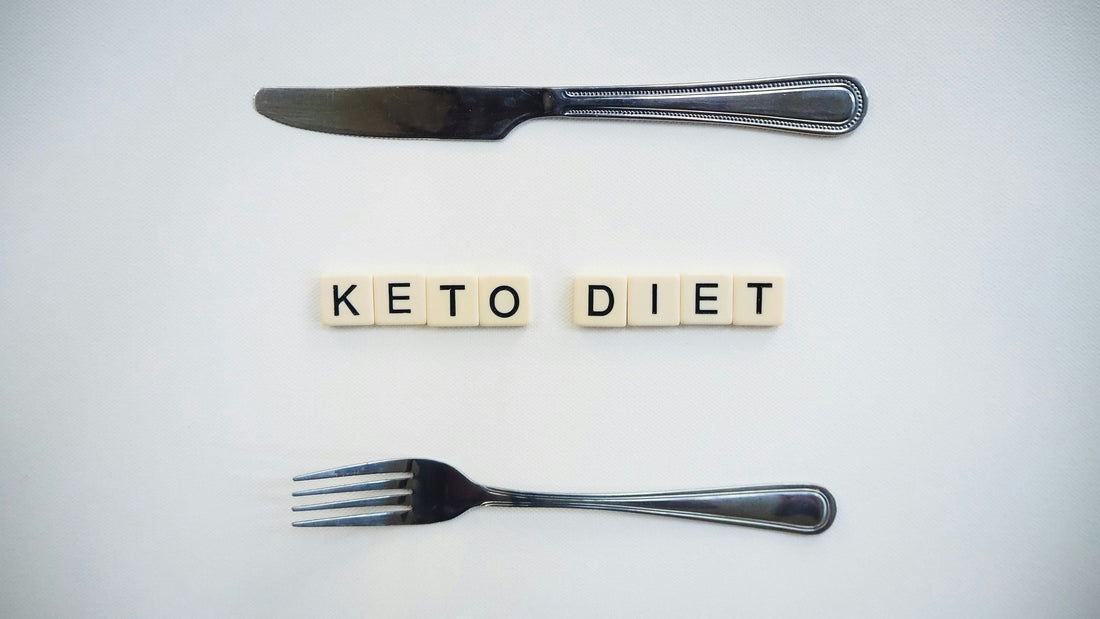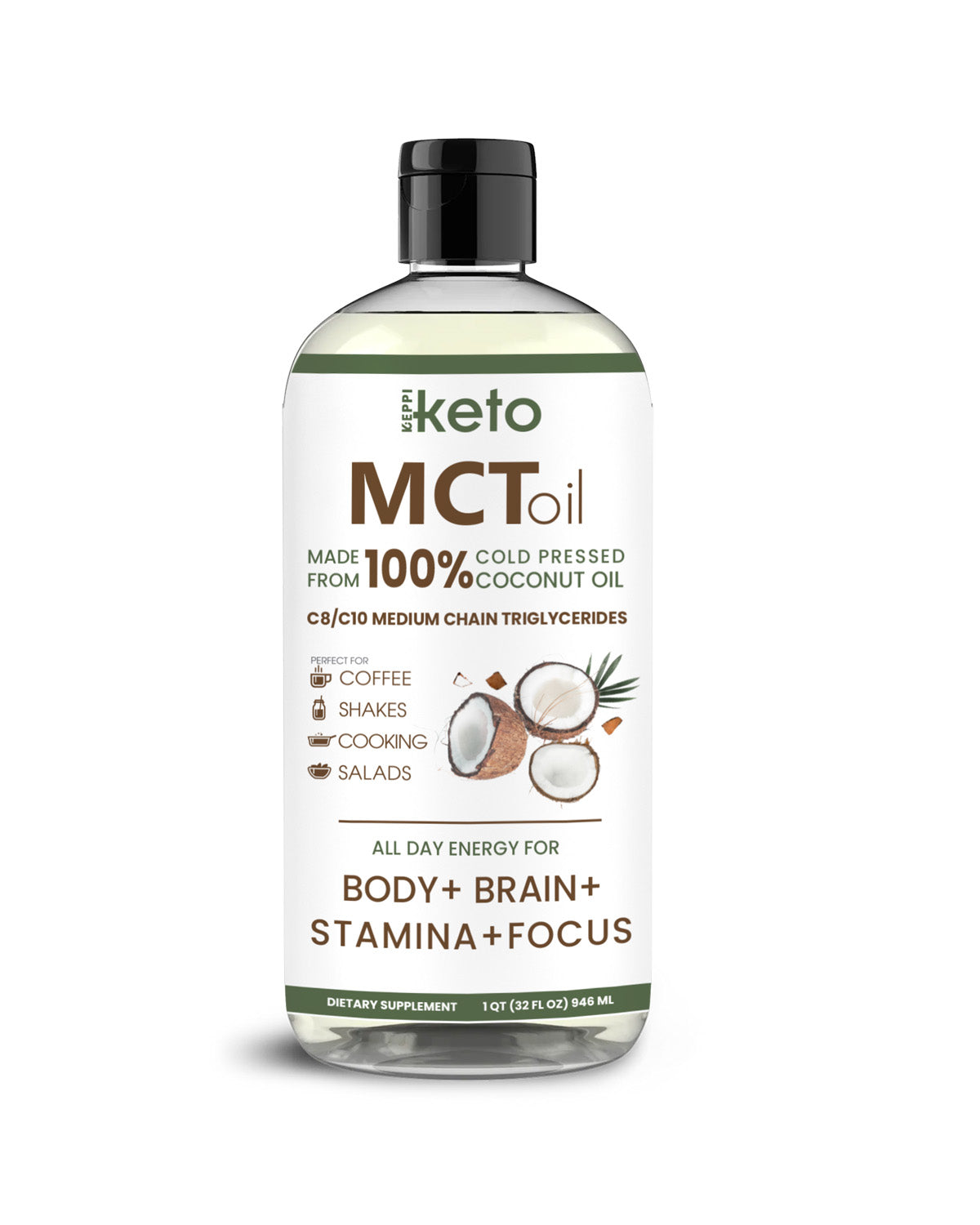
Ketone Power 101: Why MCT Oil Is the Shortcut to Steady Energy
Share
Keywords: MCT oil, C8 MCT, C10 MCT, ketone production, ketosis, medium-chain triglycerides, keto diet, ketone energy, brain fuel, Keppi MCT Oil, coconut-derived MCT, clean energy, insulin response, fat adaptation, how to use MCT oil, best MCT for ketosis.
Kick-Start Your Ketones: Why MCTs Are the Fast Track
Trying to flip your metabolic switch, yet the promised energy transition keeps sputtering? Rapid absorption of medium-chain triglycerides (MCTs) sends fat straight to your liver, ramping ketone production before your coffee even cools—giving quick fuel for brain and muscle (Bach & Babayan, 1982; St-Onge & Jones, 2002).
In the next few minutes, you’ll see exactly how this quick fuel works. We’ll cover MCT benefits for ketone availability and keto adaptation, plus practical tactics to keep your ketogenic goals on track every day (Courchesne-Loyer et al., 2013; Clegg, 2010).
What You'll Learn about What role do MCTs play in ketone production?
- Why rapid absorption drives near-immediate ketone production, sharpening mental focus and sustaining physical energy (Bach & Babayan, 1982; Courchesne-Loyer et al., 2013)
- How smart timing of MCT doses eases the “metabolic switch” and supports fat adaptation (Cunnane et al., 2016)
- Dosing that supports GI comfort and steady energy (St-Onge & Jones, 2002)
- Simple ways to slide MCTs into coffee, fasting windows, or pre-workout without fuss
- Common pitfalls that slow ketone rise—and quick fixes
TL;DR: The Fast Lane to Ketone Power
MCT oil rapidly boosts ketone production by bypassing most fat-digestion steps and traveling directly to the liver. C8 and C10 raise circulating ketones and can support clean, steady energy and keto adaptation when dosed wisely (Bach & Babayan, 1982; Courchesne-Loyer et al., 2013). For real-world results, a coconut-derived C8/C10 like Keppi MCT Oil is an easy daily tool.
Learn more about the productWhat Are the Best Education Topics for MCT-Driven Ketone Production?
- Chain Length & Absorption Speed – how medium chains reach the liver quickly (Bach & Babayan, 1982)
- Portal Vein Delivery & Liver Metabolism – the direct highway that sparks rapid ketogenesis (St-Onge & Jones, 2002)
- Ketones as a Reliable Energy Substrate – steady output that supports fat oxidation (Cunnane et al., 2016)
- Metabolic & Glycaemic Considerations – aligning strategy with stable energy (St-Onge & Jones, 2002)
- Neurological Support Mechanisms – cognition and epilepsy research tied to ketones (Reger et al., 2004; Neal et al., 2008; Chang et al., 2016)
Chain Length & Absorption Speed
You’re dealing with fatty acids that contain ~6–12 carbons. Their shorter chain length means they require little to no micellar packaging and are absorbed and transported faster than long-chain fats (Bach & Babayan, 1982). Within minutes, MCTs cross the gut wall and are delivered to the liver, where they can be converted into ketone bodies (Courchesne-Loyer et al., 2013). C8 (caprylic) typically yields higher ketone levels per gram than C10 (capric), making C8-rich blends popular for a rapid boost (St-Pierre et al., 2019; Vandenberghe et al., 2017).
- C8 > C10 > C12 for speed of ketone appearance (St-Pierre et al., 2019)
- Minimal bile dependence supports smoother digestion (Bach & Babayan, 1982)
- Faster hepatic delivery reduces likelihood of storage (St-Onge & Jones, 2002)

Portal Vein Delivery & Liver Metabolism
Unlike most long-chain triglycerides that detour through chylomicrons and the lymph, MCTs travel largely via the portal vein straight to the liver (Bach & Babayan, 1982). There, β-oxidation generates acetyl-CoA that is quickly diverted to ketone bodies—β-hydroxybutyrate and acetoacetate—raising circulating ketones without a carbohydrate load (St-Onge & Jones, 2002; Courchesne-Loyer et al., 2013).
- Direct hepatic route = fewer processing steps
- Supports fat oxidation over storage (St-Onge & Jones, 2002)
- Complements fasting or low-carb periods
“MCTs are uniquely absorbed and transported to the liver where they are rapidly oxidized and can increase circulating ketone bodies—even in the absence of strict carbohydrate restriction.”
Ketones as a Reliable Energy Substrate
Once in circulation, ketones efficiently fuel neurons and muscle. In the brain, ketones can supplement or substitute for glucose and may support cognitive performance in some contexts (Cunnane et al., 2016; Reger et al., 2004). For endurance, moderate ketone availability may help steady energy during low-to-moderate efforts (Cox & Clarke, 2014).
- Stable ATP delivery with fewer glucose swings (Cunnane et al., 2016)
- Potential cognitive support in mild impairment (Reger et al., 2004)
- Useful during fasting windows or long work blocks
Metabolic & Glycaemic Considerations
Replacing part of dietary fat with MCTs has been linked to modest increases in energy expenditure and favorable body-composition trends in some trials, while offering a ketone “bridge” during keto adaptation (St-Onge & Jones, 2002; Mumme & Stonehouse, 2015). While MCTs are not a treatment for glycaemic disorders, their low glycaemic impact and ketone rise can align with a steady-energy strategy when paired with an overall healthy plan.
Neurological Support Mechanisms
Ketogenic therapies—including MCT-based protocols—have long been used as an option in refractory epilepsy, with MCT formulations enabling higher carbohydrate tolerance at similar efficacy in some patients (Neal et al., 2008). Mechanistically, decanoic acid (C10) may exert direct antiseizure effects independent of ketones (Chang et al., 2016), while modest ketone elevations from MCT intake have shown acute cognitive benefits in small studies of mild cognitive impairment (Reger et al., 2004).
Practical Solution: Accelerate Ketone Levels With Keppi MCT Oil
Slow ketone uptake can stall progress. A clean C8–C10 blend such as Keppi MCT Oil helps raise β-hydroxybutyrate within minutes and pairs well with coffee, fasting windows, or pre-workout routines (Courchesne-Loyer et al., 2013; St-Pierre et al., 2019).
Implementation Guide: Four Simple Steps
- Start small: 1 tsp in hot coffee/tea on day one to check tolerance (St-Onge & Jones, 2002).
- Scale gradually: after 2–3 days, increase to 1 tbsp with breakfast for a morning ketone lift.
- Strategic pairing: combine with a low-carb meal to steady energy through midday.
- Training days: add 1 tsp 30 minutes pre-workout for quick-oxidizing fuel.
MCT Oil: The Ketone Catalyst

Keppi C8 C10 MCT Oil
Coconut-derived, flavorless C8/C10 for rapid, clean ketone energy. Blends into coffee, shakes, or dressings and supports keto, fasting, and focus routines. Produced in GMP-compliant facilities.
Benefit Overview: Our C8–C10 Edge
- Higher C8 content is associated with a larger, faster ketone rise per gram (St-Pierre et al., 2019).
- Neutral taste and texture for easy daily adherence.
- Coconut-only sourcing; produced under quality standards for purity.
Follow these steps for two weeks and track energy, satiety, training output, and GI comfort. Adjust the serving to your goal and tolerance.
Conclusion
MCTs bypass much of standard fat digestion, reach the liver quickly, and elevate ketone bodies—providing a reliable energy complement for keto, fasting, and focus. Start low, titrate up, and time servings around work blocks or training to lock in a smooth metabolic transition (St-Onge & Jones, 2002; Courchesne-Loyer et al., 2013).
Ready to Supercharge Your Keto Journey?
Don’t leave your results to chance. Add Keppi MCT Oil to your routine and unlock rapid, reliable ketone energy for both mind and body. Learn more about how it works.
Learn MoreReferences
- Bach, A.C. & Babayan, V.K. (1982) Medium-chain triglycerides: an update. American Journal of Clinical Nutrition, 36(5), 950–962.
- St-Onge, M-P. & Jones, P.J.H. (2002) Physiological effects of medium-chain triglycerides: potential agents in the prevention of obesity. Journal of Nutrition, 132(3), 329–332.
- Courchesne-Loyer, A. et al. (2013) Stimulation of mild ketonemia with medium-chain triglycerides in healthy humans: dose-response and metabolic effects. Nutrition, 29(5), 653–658.
- Cunnane, S.C. et al. (2016) Can ketones compensate for deteriorating brain glucose uptake during aging? Frontiers in Molecular Neuroscience, 9, 53.
- Reger, M.A. et al. (2004) Effects of beta-hydroxybutyrate on cognition in memory-impaired adults. Neurobiology of Aging, 25(3), 311–314.
- Neal, E.G. et al. (2008) The ketogenic diet for the treatment of childhood epilepsy: a randomised controlled trial. Lancet Neurology, 7(6), 500–506.
- Chang, P. et al. (2016) Seizure control by decanoic acid through direct AMPA receptor inhibition. Brain, 139(2), 431–443.
- Clegg, M.E. (2010) Medium-chain triglycerides are advantageous in promoting weight loss although not beneficial to exercise performance. International Journal of Food Sciences and Nutrition, 61(7), 653–679.
- St-Pierre, V. et al. (2019) Plasma ketone and medium-chain fatty acid response in humans consuming different medium-chain triglycerides. Nutrition & Metabolism, 16, 9.
- Vandenberghe, C. et al. (2017) Caprylic acid (C8) rapidly increases plasma ketones: a randomized trial. Clinical Nutrition ESPEN, 20, 1–6.
- Mumme, K. & Stonehouse, W. (2015) Effects of medium-chain triglycerides on weight loss and body composition: a meta-analysis. Journal of the Academy of Nutrition and Dietetics, 115(2), 249–263.
- Cox, P.J. & Clarke, K. (2014) Acute nutritional ketosis: implications for exercise performance. Nutrition & Metabolism, 11, 17.
